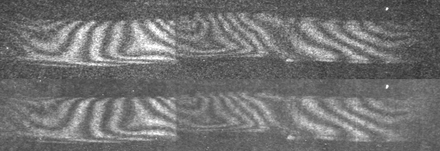Results_and_Discussion3
3.2.4.3 Results and Discussion
We can draw conclusions about the process of the violin body deformation by the sole qualitative analysis of interference fringe structure. The shape of interference fringes for the handmade concert violin (Fig. 3–47) is adequate to the support deflection line, which verifies the assumption that the theoretical (calculated) deflection line of the support nearly merges with the measured one (by holographic interferometry).
However, the factory violin show neither the interference fringe shape similar to the support deflection nor the direction of interference fringe displacement (Fig. 3–46). Measurements further showed that the violin building technology, i.e. application of prestresses to both the top and the bottom soundboards, as well as thickness and shape of the plates influence the violin body deflection.
a)

b)

c)

d)

e)
 Fig. 3–46 Analysis of the factory violin statics
Fig. 3–46 Analysis of the factory violin staticsa) Action of the forces on the whole violin
b) Action of the forces on the violin body
c) Holographic interferograms from two views in the y-axis direction
d) Display of the violin body as the support
e) Calculated and measured deflection line
a)

b)
 Fig. 3–47 Analysis of the concert violin statics
Fig. 3–47 Analysis of the concert violin staticsa) Holographic interferograms from two views in the y-axis direction
b) Calculated and measured deflection line
The appropriate tension state in the violin body belongs to the significant factors determining the instrument quality. Undoubtedly, all the other factors, such as material elasticity represented by Young module or material density also influence the most important factor, which is the tension in the final phase of a violin body building.


a)b)
Fig. 3–48 Frame model of the violin1 – top soundboard, 2 – tension of strings, 3 – bottom soundboard,
F – tension acting force
a) without purfle 1
b) compounded from several purfles
For better understanding of force and tension actions within the violin body we consider the frame violin model compounded from several purfles (Fig. 3–48 a). The factory (serial) production not always ensures the elimination of the top soundboard compression caused by string tension. The top soundboard compression shifts the main formant of the spectrum towards lower frequencies, which causes the loss of carrying-capacity and tunefulness of the instrument.
In the picture we can see that purfles 1 and 3 are adequate to the top and bottom boards while purfle 2 to the strings. Generally, if during the assembling of the components we omit purfle 1 (Fig. 3–48 b), the load from the strings is transferred through the ribs with blocks on the bottom board that is adequate to the purfle 3. If we assembled the purfle 1 into the body at this state, this purfle would not be loaded by any force, while reduction of the tension by force F would activate the tension forces in the purfle adequate to the top board. From this model it is seen how it is possible to realise the change of internal forces in the violin body by appropriate assembling technology. Also for this purpose, the holographic experiments aimed at diagnostics of the violin body under the bridge pressure caused by string tension were carried out.


